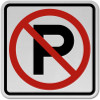 In the MVA under section 189 it states that: (1) Except when necessary to avoid conflict with traffic or to comply with the law or the directions of a peace officer or traffic control device, a person must not stop, stand or park a vehicle as follows: (k) alongside or opposite a street excavation or obstruction when stopping, standing or parking obstructs traffic;
In the MVA under section 189 it states that: (1) Except when necessary to avoid conflict with traffic or to comply with the law or the directions of a peace officer or traffic control device, a person must not stop, stand or park a vehicle as follows: (k) alongside or opposite a street excavation or obstruction when stopping, standing or parking obstructs traffic;
Does this mean that if there is an obstruction on the opposite side of the road, that you cannot park on the other side. For example, in my area, in the summers we get a large influx of sports fisherman and they often park along both sides of the road forcing traffic to drive up the middle. I want to know if this law prevents such parking, can they legally park on both sides or is only one side of the road legal due to obstructions created by the other parked vehicles? The road in question is a risen, two lane, country road with no sidewalks and sharp angles on each side which prevent parking all the off the road.
As you can see in the street view there are some vehicles present and parked partially on the road but only one side. When it really picks up both sides will be parked on for nearly 100m to the East if not a little more as there is river access through a trail in one of the fields in that direction. This will often force single lane traffic and due to the slight curve in the road a blind spot that will sometimes lead to two cars coming face to face. No to mention the 30Km speed sign posted that is often obstructed by parked vehicles.
There are a number of sections in the Motor Vehicle Act that restrict parking (empty vehicle), standing (driver inside but vehicle not moving) or stopping (vehicle movement has ceased). I'll start with the following:
Where parking prohibited
187 (1) Subject to subsection (3), if outside of a business or residence district it is practicable to stop, park or leave a vehicle off the roadway, a person must not stop, park or leave the vehicle either unattended or attended on the roadway.
(2) Subject to subsection (3), a person must not park a vehicle so as to obstruct the free passage of traffic on the highway.
(3) Subsections (1) and (2) do not apply when a vehicle is so disabled that it is not practicable to avoid stopping and temporarily leaving it on a highway.
As you can see, if it is not possible to get completely off the roadway, in your example off of the pavement, one can still park if free passage of traffic is not blocked. Some level of impingement is allowed as part of the vehicle may be on the roadway.
In your example, if someone is already parked partly onto the pavement they may be an obstruction, so parking on the other side of the road from them would not be allowed.
Obstruct is not defined in the Motor Vehicle Act, so the dictionary definition is acceptable to the court:
Obstruct (verb)
- block (an opening, path, road, etc.); be or get in the way of
- prevent or hinder (movement or someone or something in motion)
- deliberately make (something) difficult
I would be reluctant to issue a ticket or tow a vehicle if there was room for traffic to pass one way at a time for a short distance and no safety hazard was created by traffic waiting their turn to go through given my experience in traffic court.
If this is an issue with local residents, it would be far simpler to deal with if the Ministry could be convinced to post one or both sides with no parking signs. There would then be no doubt in anyone's mind (drivers, police and the courts) about the situation.
- Log in to post comments
The huge increase of onstreet parking at high density residential development on some of the busy streets is quite alarming. I thought that it had been resolved in the 1970's and '80's but it appears to be growing out of all control now. A bit scary.
Other than attempting to avoid those areas, slowing down and crowding the center line there is little one can do.
Perhaps charging the districts with negligence when issues arise might do the trick.
It is a result of increased land prices and population density - we had better slow right down or the future is bleak - already our cities are starting to look like slums in the new business areas.
- Log in to post comments
- Log in to post comments

Answer